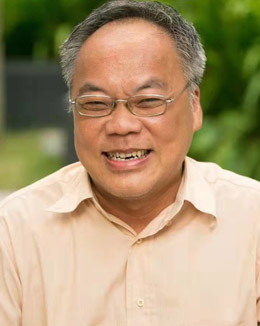Keynote Speaker

Prof. Eddie Yin-Kwee NG
Ph.D., FNAT [USA], AEUAS & AEASA [EU], FAIMBE & FASME [USA], FAIIA, FIETI & FAPTSA [HK], DFIDSAI [CN], FIET [UK], Nanyang Technological University, SingaporeSpeech Title: Improving Dual-Frequency Sonothrombolysis Outcomes through Phase Shifting
Abstract: Sonothrombolysis is a technique to remove blood clot from vessels by using ultrasound waves to induce acoustic cavitation (formation of microbubbles). Recent studies have demonstrated improved sonothrombolytic efficacy when using two ultrasound waves of different frequencies (dual-frequency ultrasound). Nevertheless, our recent study [1-5] suggested that an improper selection of the ultrasound frequency, specifically when one frequency is an integer multiplier of another, can weaken the cavitation intensity and the flow-induced shear stress, leading to poor sonothrombolysis outcomes. This is due to the destructive interference at these frequencies, which reduces the pressure amplitude of the resultant waves that incident on the microbubble. In this study, we investigated the hypothesis that destructive interference due to improper frequency selection can be alleviated by shifting the phase between the two ultrasound waves. To that end, a finite element model of the microbubble undergoing ultrasound-induced oscillation was developed. When ultrasound of 0.5 MHz was paired with 1 MHz, a phase shift of 270° led to shear stress of 22.5 kPa, which was one order of magnitude higher than the case without phase shift. The results obtained showed that a correctly chosen phase shift can overcome the weakened cavitation of two ultrasound waves with frequencies being an integer multiplier of another. In contrast, non-integer multipliers of frequency pairings did not show significant influence of phase shift on cavitation and shear stress. Findings from this study provide new insights into the biomechanics behind sonothrombolysis with dual-frequency ultrasound. This allows an excellent starting point for future advancement and optimisation of this treatment.
References:
[1]. ZQ Tan, EH Ooi, YS Chiew, JJ Foo, EYK Ng, ET Ooi, “Enhancing sonothrombolysis outcomes with dual-frequency ultrasound: insights from a microbubble dynamics study”, Computers in Biology and Medicine, (2024), Vol. 181, pp. 109061 (11 pages), (IF: 7.7, Q1, Rank: 19/93 in Biology) https://doi.org/10.1016/j.compbiomed.2024.109061.
[2]. ZQ Tan, EH Ooi, YS Chiew, JJ Foo, EYK Ng, ET Ooi, “Delineating the effects of ultrasound and microbubble parameters on the outcome of sonothrombolysis: a computational analysis on the microbubble dynamics”, Biocybernetics and Biomedical Engineering, (2024), 44(2), pp. 358-368, https://doi.org/10.1016/j.bbe.2024.04.003.
[3]. Zhi Q Tan, Ean H Ooi, Yeong S Chiew, Ji J Foo, EYK Ng, ET Ooi, “A computational framework for the Multiphysics simulation of microbubble-mediated sonothrombolysis using a forward-viewing intravascular transducer”, Ultrasonics, Vol. 131, (2023), pp. 106961, (12 pages), https://doi.org/10.1016/j.ultras.2023.106961.
[4]. ZQ Tan, EH Ooi, YS Chiew, JJ Foo, EYK Ng, ET Ooi, “Competing Effect of Jetting During Microbubble-Mediated Sonothrombolysis”, M.J.M. Mokhtarudin et al. (eds.), Proceedings of the Annual Congress of the Asia-Pacific Society for Artificial Organs, Lecture Notes in Bioengineering, Springer Nature, Singapore. https://doi.org/10.1007/978-981-97-1920-4_2.
[5]. ZQ Tan, EH Ooi, YS Chiew, JJ Foo, EYK Ng, ET Ooi, “A Computational Study on the Use of Phase Shift to Improve Dual-Frequency Sonothrombolysis Outcomes”, 8th IEEE-EMBS Conference on Biomedical Engineering and Sciences (IECBES2024), 11-13th Dec 2024, Penang, Malaysia. (accepted) paper #1571061932.
Biography:
Dr. Eddie obtained Ph.D. at Cambridge Univ. with a Cambridge Commonwealth Scholarship.
He is elected as:
• Fellow (inaugural) for National Academy of Technology (USA);
• Academician for European Academy of Sciences and Arts (EU-Austria);
• Academician for European Academy of Sciences (EU-Greece);
• Fellow (Life) of the American Society of Mechanical Engineers (USA);
• Fellow of Institute of Engineering and Technology (United Kingdom);
• Fellow of Industry Academy: International Artificial Intelligence Industry Alliance (HK),
• Fellow of International Engineering and Technology Institute (Hong Kong),
• Fellow of Asia-Pacific Technological Sciences Academy (Hong Kong),
• Distinguished Fellow for Institute of Data Science and Artificial Intelligence, (China), and,
• Fellow of the American Institute for Medical and Biological Engineering (USA) with his citation reads: "For outstanding contributions in non-contact, early detection of human-health abnormality non-invasively with infrared-physics-technology".
Eddie received 2022 Alumni Highly Commended Award from the VC of Newcastle University, UK for his contributions to the society and achievements as academia. Winner of the 2024 2nd IETI (International Engineering and Technology Institute) Ramesh Agarwal Lifetime Achievement Award in Science, Engineering or Technology. This award honors individuals with lifetime achievements in research, education, and service towards the advancement of any discipline of engineering and technology.
Since 1992, he works as Faculty in the School of Mechanical & Aerospace Engineering in Nanyang Technological University, Singapore. He is the: Lead Editor-in-Chief for the ISI Journal of Mechanics in Medicine and Biology for dissemination of original research in all fields of mechanics in medicine and biology since 2000; & Lead Editor-in-Chief for the ISI Journal of IET - AI in Surgery for dissemination of original research in integrating of artificial intelligence, surgery, and biomedical engineering, since 2024; https://www.worldscientific.com/page/iet/ai-surgery
He is included in the Stanford list of the World’s top 2% Scientists since 2019 (ranked <80 out of 64,425 as 0.001% in the field of Biomedical Engineering). The ranking method is calculated by removing the self-citation of the literature. His Google Scholar (h-index: 73+) can be found in: [http://scholar.google.com.sg/citations?user=9QW1LYAAAAAJ].
